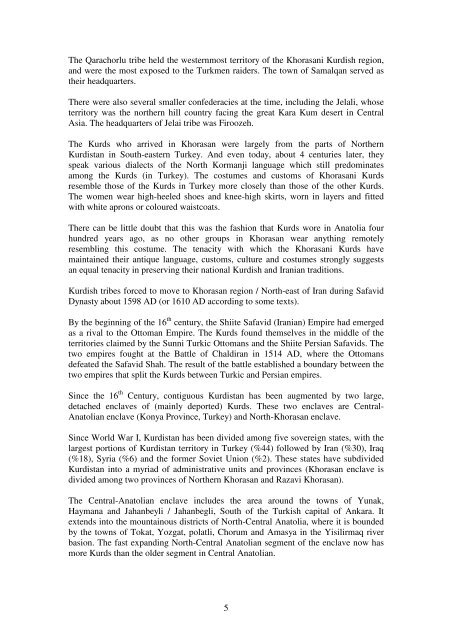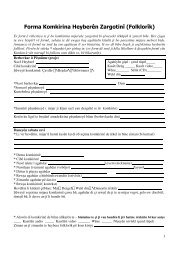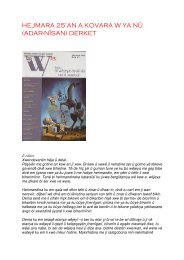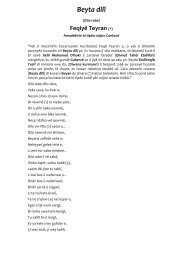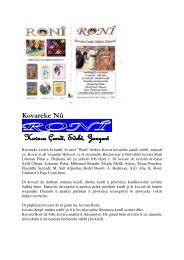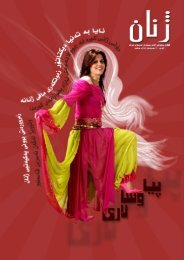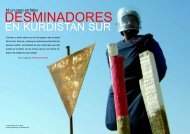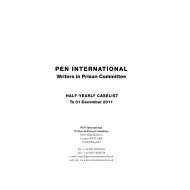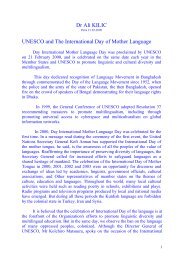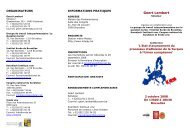The Kurds in Khorasan, North-east of Iran - Pen-Kurd
The Kurds in Khorasan, North-east of Iran - Pen-Kurd
The Kurds in Khorasan, North-east of Iran - Pen-Kurd
You also want an ePaper? Increase the reach of your titles
YUMPU automatically turns print PDFs into web optimized ePapers that Google loves.
<strong>The</strong> Qarachorlu tribe held the westernmost territory <strong>of</strong> the <strong>Khorasan</strong>i <strong>Kurd</strong>ish region,and were the most exposed to the Turkmen raiders. <strong>The</strong> town <strong>of</strong> Samalqan served astheir headquarters.<strong>The</strong>re were also several smaller confederacies at the time, <strong>in</strong>clud<strong>in</strong>g the Jelali, whoseterritory was the northern hill country fac<strong>in</strong>g the great Kara Kum desert <strong>in</strong> CentralAsia. <strong>The</strong> headquarters <strong>of</strong> Jelai tribe was Firoozeh.<strong>The</strong> <strong><strong>Kurd</strong>s</strong> who arrived <strong>in</strong> <strong>Khorasan</strong> were largely from the parts <strong>of</strong> <strong>North</strong>ern<strong>Kurd</strong>istan <strong>in</strong> South-<strong>east</strong>ern Turkey. And even today, about 4 centuries later, theyspeak various dialects <strong>of</strong> the <strong>North</strong> Kormanji language which still predom<strong>in</strong>atesamong the <strong><strong>Kurd</strong>s</strong> (<strong>in</strong> Turkey). <strong>The</strong> costumes and customs <strong>of</strong> <strong>Khorasan</strong>i <strong><strong>Kurd</strong>s</strong>resemble those <strong>of</strong> the <strong><strong>Kurd</strong>s</strong> <strong>in</strong> Turkey more closely than those <strong>of</strong> the other <strong><strong>Kurd</strong>s</strong>.<strong>The</strong> women wear high-heeled shoes and knee-high skirts, worn <strong>in</strong> layers and fittedwith white aprons or coloured waistcoats.<strong>The</strong>re can be little doubt that this was the fashion that <strong><strong>Kurd</strong>s</strong> wore <strong>in</strong> Anatolia fourhundred years ago, as no other groups <strong>in</strong> <strong>Khorasan</strong> wear anyth<strong>in</strong>g remotelyresembl<strong>in</strong>g this costume. <strong>The</strong> tenacity with which the <strong>Khorasan</strong>i <strong><strong>Kurd</strong>s</strong> havema<strong>in</strong>ta<strong>in</strong>ed their antique language, customs, culture and costumes strongly suggestsan equal tenacity <strong>in</strong> preserv<strong>in</strong>g their national <strong>Kurd</strong>ish and <strong>Iran</strong>ian traditions.<strong>Kurd</strong>ish tribes forced to move to <strong>Khorasan</strong> region / <strong>North</strong>-<strong>east</strong> <strong>of</strong> <strong>Iran</strong> dur<strong>in</strong>g SafavidDynasty about 1598 AD (or 1610 AD accord<strong>in</strong>g to some texts).By the beg<strong>in</strong>n<strong>in</strong>g <strong>of</strong> the 16 th century, the Shiite Safavid (<strong>Iran</strong>ian) Empire had emergedas a rival to the Ottoman Empire. <strong>The</strong> <strong><strong>Kurd</strong>s</strong> found themselves <strong>in</strong> the middle <strong>of</strong> theterritories claimed by the Sunni Turkic Ottomans and the Shiite Persian Safavids. <strong>The</strong>two empires fought at the Battle <strong>of</strong> Chaldiran <strong>in</strong> 1514 AD, where the Ottomansdefeated the Safavid Shah. <strong>The</strong> result <strong>of</strong> the battle established a boundary between thetwo empires that split the <strong><strong>Kurd</strong>s</strong> between Turkic and Persian empires.S<strong>in</strong>ce the 16 th Century, contiguous <strong>Kurd</strong>istan has been augmented by two large,detached enclaves <strong>of</strong> (ma<strong>in</strong>ly deported) <strong><strong>Kurd</strong>s</strong>. <strong>The</strong>se two enclaves are Central-Anatolian enclave (Konya Prov<strong>in</strong>ce, Turkey) and <strong>North</strong>-<strong>Khorasan</strong> enclave.S<strong>in</strong>ce World War I, <strong>Kurd</strong>istan has been divided among five sovereign states, with thelargest portions <strong>of</strong> <strong>Kurd</strong>istan territory <strong>in</strong> Turkey (%44) followed by <strong>Iran</strong> (%30), Iraq(%18), Syria (%6) and the former Soviet Union (%2). <strong>The</strong>se states have subdivided<strong>Kurd</strong>istan <strong>in</strong>to a myriad <strong>of</strong> adm<strong>in</strong>istrative units and prov<strong>in</strong>ces (<strong>Khorasan</strong> enclave isdivided among two prov<strong>in</strong>ces <strong>of</strong> <strong>North</strong>ern <strong>Khorasan</strong> and Razavi <strong>Khorasan</strong>).<strong>The</strong> Central-Anatolian enclave <strong>in</strong>cludes the area around the towns <strong>of</strong> Yunak,Haymana and Jahanbeyli / Jahanbegli, South <strong>of</strong> the Turkish capital <strong>of</strong> Ankara. Itextends <strong>in</strong>to the mounta<strong>in</strong>ous districts <strong>of</strong> <strong>North</strong>-Central Anatolia, where it is boundedby the towns <strong>of</strong> Tokat, Yozgat, polatli, Chorum and Amasya <strong>in</strong> the Yisilirmaq riverbasion. <strong>The</strong> fast expand<strong>in</strong>g <strong>North</strong>-Central Anatolian segment <strong>of</strong> the enclave now hasmore <strong><strong>Kurd</strong>s</strong> than the older segment <strong>in</strong> Central Anatolian.5


